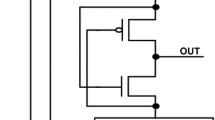Abstract
Leakage power dissipation is a serious concern in deep nanometer devices. Low power design methodology is often adopted in VLSI circuits and systems to minimize power; however, this is achieved at the cost of performance penalty. In this paper, we first review the existing circuit techniques for leakage minimization. A new circuit technique is then proposed which is designed intelligently by mixing a pair of dynamic threshold sleep transistors and a pair of helper transistors. The performance of the proposed technique is investigated in terms of area, power, delay and power–delay product. Extensive SPICE simulation with 32 nm process technology shows a significant reduction in power, delay and power–delay product.















Similar content being viewed by others
Abbreviations
- DTMOS:
-
Dynamic threshold MOS
- MTCMOS:
-
Multi-threshold CMOS
- LFA:
-
Leakage feedback approach
- SKA:
-
Sleepy keeper approach
- DG:
-
Drain gating
- PUN:
-
Pull-up network
- PDN:
-
Pull-down network
- PDP:
-
Power–delay product
- LCTs:
-
Leakage control transistors
- \({V}_{\mathrm{t}}\) :
-
Threshold voltage
- GLBB:
-
Gate-level body bias
- DLSL:
-
Dynamic logic suppression logic
References
A. Abdollahi, F. Fallah, M. Pedram, Leakage current reduction in CMOS VLSI circuits by input vector control. IEEE Trans. Very Large Scale Integr. Syst. 12, 140–154 (2004)
A. Agarwal, C.H. Kim, S. Mukhopadhyay, K. Roy, Leakage in nano-scale technologies: mechanisms, impact and design considerations, in ACM/IEEE Design Automation Conference, pp. 6–11 (2004)
A.P. Chandrakasan, Low-power CMOS digital design. IEEE J. Solid State Circuit 27, 473–484 (1992)
K. Chopra, S.B.K. Vrudhula, Implicit pseudo Boolean enumeration algorithms for input vector control, inProceedings of IEEE-ACM Design Automation Conference, pp. 767–772 (2004)
P. Corsonello, M. Lanuzza, S. Perri, Gate-level body biasing technique for high speed sub-threshold CMOS logic gates. Int. J. Circuit Theory Appl. 42, 65–70 (2014)
J.W. Chun, C.Y. Roger Chen, A Novel leakage reduction technique for CMOS circuit design, in: Proceedings of ISOCC, pp. 119–122 (2010)
A.J. Drake, N. Zamdmer, K.J. Nowka, R.B. Brown, Analysis of the impact of gate body signal phase on DTMOS Inverters in \(0.13\mu \text{m}\) PD-SOI, in IEEE International SOI Conference, pp. 99–100 (2003)
H. Fuketa, M. Hashimoto, Y. Mitsuyama, T. Onoye, Transistor variability modeling and its validation with ring-oscillation frequencies for body-biased sub-threshold circuits. IEEE Trans Very Large Scale Integr. Syst. 18, 1118–1129 (2010)
N. Hanchate, N. Ranganathan, Lector: a technique for leakage reduction in CMOS circuits. IEEE Trans. VLSI Integr. Syst. 22, 196–205 (2004)
M. Horowitz, Low-power digital design, in International Symposium on Low Power Electronics and Design, pp. 8–11 (1994)
Y.T. Ho, T.T. Hwang, Low power design using dual threshold voltage, in IEEE ASP Design Automation Conference, pp. 205–208 (2004)
K. Hun, V.J. Mooney, Sleepy keeper: a new approach to low-leakage power VLSI design, in Proceedings of 2006 IFIP International Conference on Very Large Scale Integration, pp. 367–372 (2006)
J. Kao, A. Chandrakasan, MTCMOS sequential circuits, in Proceedings of European Solid-State Circuits Conference, pp. 332–335 (2001)
W. Lim, I. Lee, D. Sylvester, D. Blaauw, Batteryless Sub-nW Cortex-M0+ processor with dynamic leakage-suppression logic, in IEEE International Solid-State Circuits Conference (ISSCC), pp. 146–147 (2015)
S. Mutoh, T. Douseki, Y. Matsuya, T. Aoki Member, S. Shigematsu, J. Yamada, 1-V power supply high-speed digital circuit technology with multithreshold-voltage CMOS. IEEE J. Solid State Circuits 30, 847–854 (1995)
B.C. Paul, Device optimization for digital sub-threshold logic operation. IEEE Trans. Electron Device 52, 237–247 (2005)
K .Roy, W. Liqiong, C. Zarping, Multiple-\(\text{ V }_{{\rm dd}}\) multiple-\(\text{ V }_{{\rm th}}\) CMOS (MVCMOS) for low power applications, in Proceedings of the 1999 IEEE International Symposium on circuits and systems, pp. 360–370 (1999)
K. Roy, S. Prasad, Low-Power CMOS VLSI Circuit Design (Wiley Interscience, New York, 2000)
A. Sayed, H. Al Asaad, A new low power high performance flip-flop, in 49th IEEE International Midwest Symposium on Circuits and Systems, pp. 723–726 (2006)
K. Srikanth, K. Dhireesha, GALEOR: leakage reduction for CMOS circuit, inproceedings of 15th IEEE International Conference on Electronics Circuits and Systems, pp. 574–577 (2008)
M.H. Sulieman, V. Beiu, W. Ibrahim, Low-power and highly reliable logic gates: transistor-level optimizations, inProceedings of 10th IEEE conference on Nanotechnology Joint Symposium with Nano Korea, pp. 254–257 (2010)
A. Tajalli, E. Vittoz, Y. Leblebici, E.J. Brauer, Ultra-low power subthreshold current-mode logic utilizing PMOS load device. IET Electron Lett. 43, 911–913 (2007)
Acknowledgments
The authors thank the Editors and the anonymous reviewers for their constructive comments and suggestions to improve the manuscript.
Author information
Authors and Affiliations
Corresponding author
Rights and permissions
About this article
Cite this article
Lorenzo, R., Chaudhury, S. Dynamic Threshold Sleep Transistor Technique for High Speed and Low Leakage in CMOS Circuits. Circuits Syst Signal Process 36, 2654–2671 (2017). https://doi.org/10.1007/s00034-016-0442-0
Received:
Revised:
Accepted:
Published:
Issue Date:
DOI: https://doi.org/10.1007/s00034-016-0442-0




